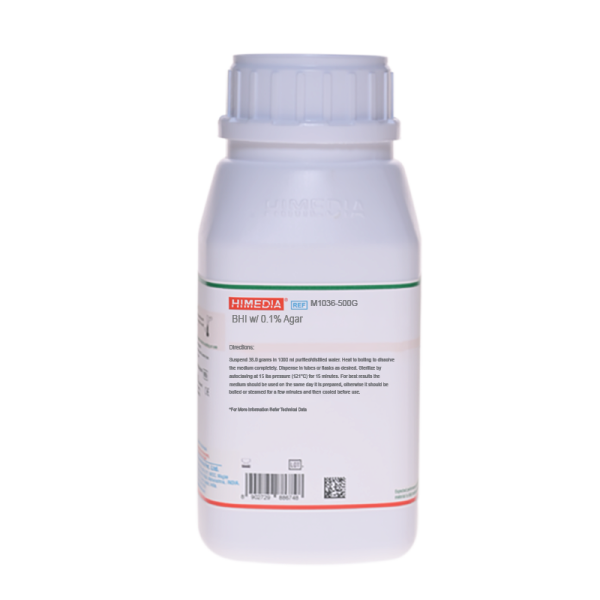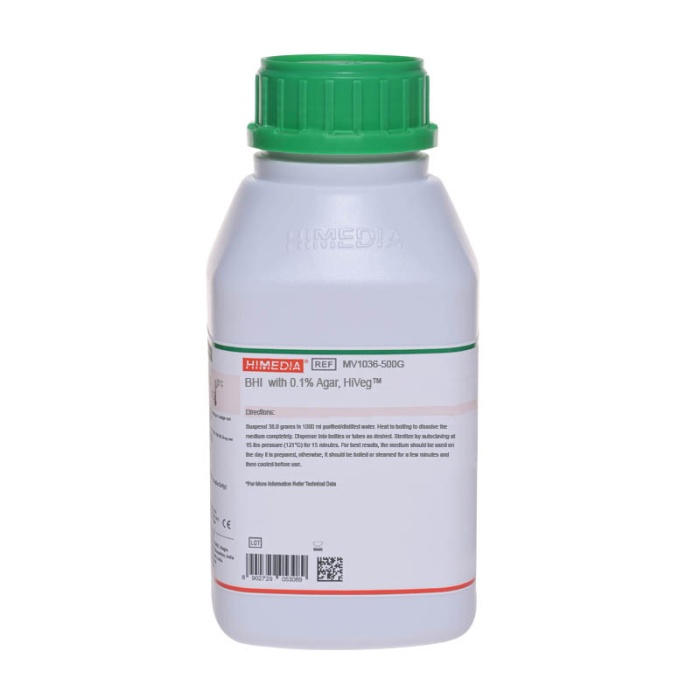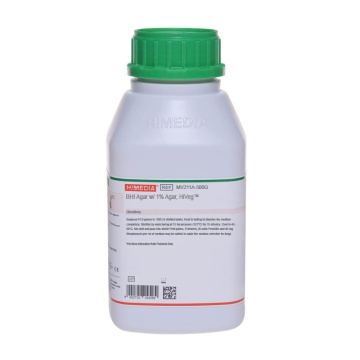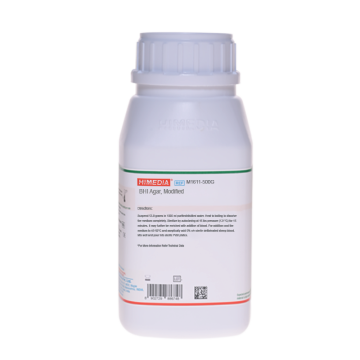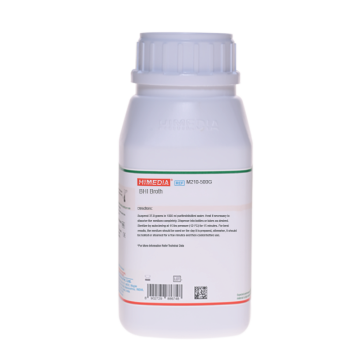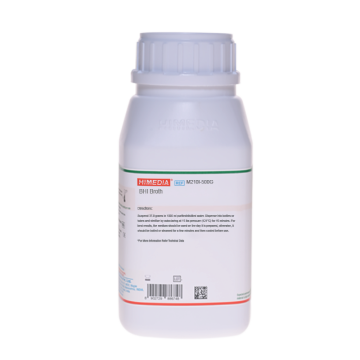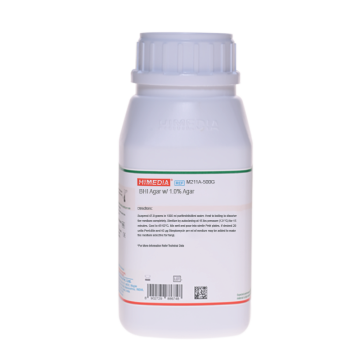 Your enquiry has been submitted
Your enquiry has been submitted
BHI w/0.1% Agar (Brain Heart Infusion w/ 0.1% Agar)
Intended Use
Recommended for propagation of fastidious pathogenic cocci and other organisms associated with blood culture work and allied pathological investigations.
Composition
| Ingredients | g/L |
|---|---|
| HM Infusion powder# | 12.500 |
| BHI Powder$ | 5.000 |
| Proteose peptone | 10.000 |
| Sodium chloride | 5.000 |
| Disodium hydrogen phosphate | 2.500 |
| Dextrose (Glucose) | 2.000 |
| Agar | 1.000 |
Final pH (at 25°C): 7.4±0.2
**Formula adjusted, standardized to suit performance parameters
# Equivalent to Calf brain, infusion from
$ Equivalent to Beef heart, infusion from
Directions
Suspend 38.0 grams in 1000 ml purified/distilled water. Heat to boiling to dissolve the medium completely. Dispense in tubes or flasks as desired. Sterilize by autoclaving at 15 lbs pressure (121°C) for 15 minutes. For best results the medium should be used on the same day it is prepared, otherwise it should be boiled or steamed for a few minutes and then cooled before use.
Principle And Interpretation
BHI Medium is useful for cultivating a wide variety of microorganisms since it is a highly nutritive medium. Brain Heart Infusion Broth is a modification of the original formulation of Rosenow, where he added pieces of brain tissues to dextrose broth (1). Brain Heart Infusion Broth is also the preferred medium for anaerobic bacteria, yeasts and moulds (2,3,4). This medium is nutritious and well buffered to support the growth of wide variety of organisms (5,6,7). With the addition of 10% defibrinated sheep blood, it is useful for isolation and cultivation of Histoplasma capsulatum (7) and other fungi. Agar in 0.1% concentration improves growth of microaerophillic and anaerobic microorganisms (6).
For selective isolation of fungi, addition of gentamicin and/or chloramphenicol is recommended (8). Proteose peptone, HM Infusion powder and BHI Powder serve as sources of carbon, nitrogen, essential growth factors, amino acids and vitamins. Dextrose serves as a source of energy. Disodium hydrogen phosphate helps in maintaining the buffering action of the medium whereas sodium chloride maintains the osmotic equilibrium of the medium. Agar in 0.1%concentration helps create appropriate conditions for growth of anaerobic bacteria.
Type of specimen
Clinical samples - Skin, wounds; Food samples
Specimen Collection and Handling
For clinical samples follow appropriate techniques for handling specimens as per established guidelines (9,10). For food samples, follow appropriate techniques for sample collection and processing as per guidelines (4). After use, contaminated materials must be sterilized by autoclaving before discarding.
Warning and Precautions
In Vitro diagnostic use. For professional use only. Read the label before opening the container. Wear protective gloves/ protective clothing/eye protection/face protection. Follow good microbiological lab practices while handling specimens and culture. Standard precautions as per established guidelines should be followed while handling clinical specimens. Safety guidelines may be referred in individual safety data sheets.
Limitation
- Individual organisms differ in their growth requirement and may show variable growth patterns on the medium.
- This medium with added 10% sheep blood, gentamicin and chloramphenicol is inhibitory to certain fungi
- Each lot of the medium has been tested for the organisms specified on the COA. It is recommended to users to validate the medium for any specific microorganism other than mentioned in the COA based on the user's unique requirement.
- Biochemical and serological tests must be performed for confirmation.
Performance and Evaluation
Performance of the medium is expected when used as per the direction on the label within the expiry period when stored at recommended temperature.
Quality Control
Appearance: Cream to light yellow homogeneous free flowing powder
Colour and Clarity of prepared medium: Light to medium amber coloured, clear solution without any precipitate
Reaction: Reaction of 3.8% w/v aqueous solution at 25°C. pH: 7.4±0.2
pH: 7.20-7.60
Cultural Response
Cultural characteristics observed after an incubation at 35-37°C for 24-48 hours.
| Organism | Inoculum (CFU) | Growth |
|---|---|---|
| Enterococcus faecalis ATCC 29212 (00087*) | 50-100 | good-luxuriant |
| Neisseria meningitidis ATCC 13090 | 50-100 | good-luxuriant |
| Streptococcus pneumoniae ATCC 6303 | 50-100 | good-luxuriant |
| Streptococcus pyogenes ATCC 19615 | 50-100 | good-luxuriant |
| Staphylococcus aureus subsp. aureus ATCC 25923 (00034*) | 50-100 | good-luxuriant |
Key: *Corresponding WDCM numbers.
Storage and Shelf Life
Store between 10-30°C in a tightly closed container and the prepared medium at 15-25°C. Use before expiry date on the label. On opening, product should be properly stored dry, after tightly capping the bottle in order to prevent lump formation due to the hygroscopic nature of the product. Improper storage of the product may lead to lump formation. Store in dry ventilated area protected from extremes of temperature and sources of ignition Seal the container tightly after use. Product performance is best if used within stated expiry period.
Disposal
User must ensure safe disposal by autoclaving and/or incineration of used or unusable preparations of this product. Follow established laboratory procedures in disposing of infectious materials and material that comes into contact with clinical sample must be decontaminated and disposed of in accordance with current laboratory techniques (9,10).
Reference
- Rosenow, 1919, J. Dental Research, 1:205.
- Atlas R. M., 1993, Handbook of Microbiological Media, 147-153, CRC Press, Boca Raton, FL.
- MacFaddin J. F., 1985, Media for Isolation-Cultivation-Identification-Maintenance of Medical Bacteria, Vol. I, Williams and Wilkins, Baltimore.
- Salfinger Y., and Tortorello M.L. Fifth (Ed.), 2015, Compendium of Methods for the Microbiological Examination of Foods, 5th Ed., American Public Health Association, Washington, D.C.
- Conant N. F., 1950, Diagnostic Procedures and Reagents, 3rd Ed., APHA Inc., New York.
- Roseburg T. et al, 1944, J. Inf. Dis., 74:131.
- Howard B., Keiser J. F., Weissfeld A. et al, 1994, Clinical and Pathogenic Microbiology, 2nd Ed., Mosby Co.
- Murray P. R., Baron J. H., Pfaller M. A., Jorgensen J. H. and Yolken R. H., (Eds.), 2003, Manual of Clinical Microbiology, 8th Ed., American Society for Microbiology, Washington, D.C.
- Isenberg, H.D. Clinical Microbiology Procedures Handbook. 2nd Edition.
- Jorgensen, J.H., Pfaller, M.A., Carroll, K.C., Funke, G., Landry, M.L., Richter, S.S and Warnock., D.W. (2015) Manual of Clinical Microbiology, 11th Edition. Vol. 1.
| Product Name | BHI w/0.1% Agar (Brain Heart Infusion w/ 0.1% Agar) |
|---|---|
| SKU | M1036 |
| Product Type | Regular |
| Physical Form | Powder |
| Origin | Animal |
| Packaging type | HDPE |
| References | 1. Rosenow, 1919, J. Dental Research, 1:205. |
| Customized Product Available | No |



